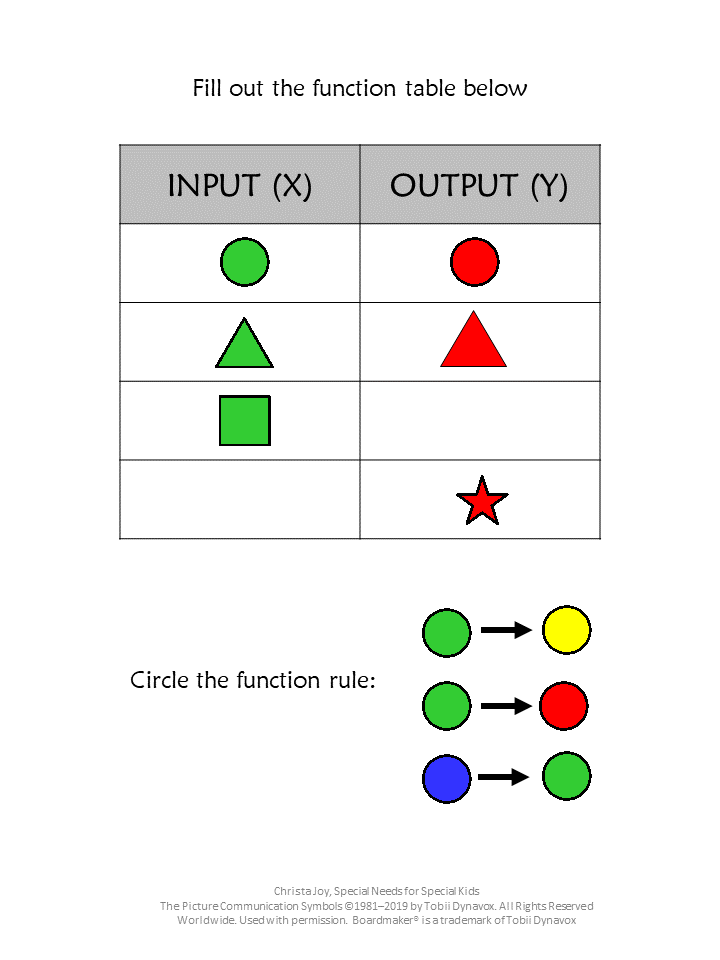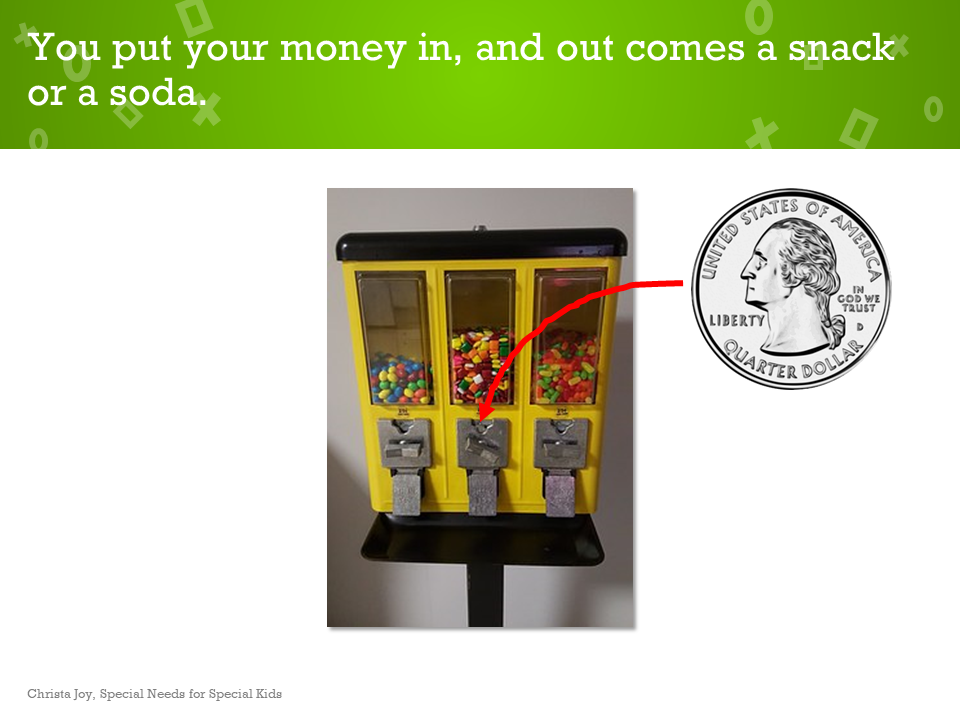Teaching high school math can be a challenge in any situation, but it can be especially challenging in special education. Most students are lacking pre-requisite skills. However, I know teachers are being expected to teach higher level math concepts to their high school students, even those with significant needs and challenges.
Topics like functions, linear equations, geometry, coordinate graphing, and even advanced algebra are all urgent requests I have gotten over the last few months. The sad reality is that these teachers are rarely given anything more than a list of standards to follow. Why? There is just very little material out there to support students with significant disabilities in the middle and high school range. So what are you to do if you are tasked with teaching high school math in a special education setting?
In this post, I want to give you some concrete, actionable tips to use and remember before jumping into these more advanced math topics. More importantly, I want you to see it is possible with the right tools and support, even your most affected students can work through these standards and gain some knowledge and understanding that may benefit them in the future. And, of course, I will have some free downloads for you to try if you still are not convinced.
1. Pre-requisite skills for high school math
Ok, let’s face it, most of the topics I mentioned above have a laundry list of pre-requisite math skills a student would need to have in order to be successful. In addition, 99% of the students coming into a high school math classroom just do not have them. It is a tough conundrum to solve for sure. But being able to shift our belief and definition about what those pre-requisite skills really are can be a game-changer.
You will never, ever be able to go back and teach all the math skills necessary to solve a linear function equation. But that does not mean you cannot still teach your students how to complete a simple function table. And, if you can get them to do that, they are right on the precipice of solving a linear equation.
When teaching high school math, meet your students WHERE THEY ARE. Rather than trying to go back and teach all the skills they never were exposed to or never learned, figure out how to use the skills they do have to teach them this material. Sounds impossible? Let’s take functions as an example.
So here is the standard: F.IF.1c Identify the input or output of a function given in table form. (see the complete standards for this high school math unit) A standard function table may look like this:

But what if you could make it look like this:

And not only that, what if you used actual objects and a real-life function machine when teaching this high school math standard? (I made this one while in the classroom, and used it for so many things. The kids loved it. CLICK HERE) With enough practice and creativity, many of your students will start to understand the input/output concept.
Students still struggling? Try moving away from quantities and leveraging those skills your students do have. Like this table:

As special ed teachers we are so good at thinking outside of the box!! Even with these more advanced standards we just need to get even more creative when teaching high school math. Be sure to download my free set of function worksheets at the end of this post.
2. Vocabulary in high school math
As we introduce these higher level concepts, I find it so helpful to take a step back and really focus on vocabulary. As much as possible, I would encourage you to use the REAL words. Do not make up cute replacements that you think will be easier for students to remember. Instead, use simple pictures to pair with these curriculum based words.

I know so many students who have learned very sophisticated words for items that are highly desirable to them. Since most, if not all, of this content will be new let’s just start off with the correct vocabulary.
Play games, practice daily, and be consistent with your use of words and symbols to deepen their understanding of this new and challenging material.
3. Real-world examples when teaching high school math
This one is probably fairly obvious to many of you. When you start on a new topic, try to relate it to items and processes your students are already familiar with.

Again, we may need to think outside of the box but it makes such a difference. Google searches were my best friend when trying to come up with ideas for some of these more advanced units. There is so much out there, it just takes some time to hunt it down.
4. Repetition and re-teaching
So, if you have followed my blog for any time or purchased any of my resources, you know how I feel about repetition. It is absolutely crucial and should never be taken for granted. When I create these high school math units, I not only make tons of worksheets (probably way more than is necessary) but I also strongly encourage teachers to use them more than once.
You can read more about the benefits and power of repetition by visiting my blog post and learn how to do it without being boring.
This is likely a brand new skill, and it will take many, many, many trials to master. Now, I do like to add some variation to the mix. Change up the objects, the quantities, the colors, even just changing the font all adds to the variety and increases the likelihood of generalization. So, repetition with variety is HUGE!!
How much time to spend on re-teaching? That is a question that can be hard to answer. If your students just do really horrible on the assessment, then I would definitely go back and re-teach for at least a week. But, here is the key: if you give the assessment BEFORE starting the topic as a pre-assessment, then you have a much better idea if there was any growth. I would often have students who only got 3 out of 10 correct on the assessment. Sounds awful right? But, they had only 1 correct on the pre-assessment. Guess what?! That is 200% growth. Without that pre-assessment piece I might feel really discouraged and spend way too much time re-teaching. How much growth is enough? Only you can decide that.
5. Using pictures when teaching high school math
So as you saw in the function table example, you can insert pictures in the place of numbers and letters as much as possible. A program I used, Hands on Equations, did a great job of this. (You can see a YouTube video about that HERE.)
Compare these two worksheets:
You may have some students than can complete this function table with the numbers. But, more likely, you have students who are not even able to read much above a 1st – 2nd grade level. Could they do the worksheet with pictures? Same exact problem, just less pre-requisite knowledge needed. I know they would need support of course, but you are more likely to make some connections and gain some independence with the second worksheet.
Hopefully, by now I have inspired you to try it. At the very least, I hope I have eased that sense of panic you may have had as your administrator handed you these “new” standards that had to be addressed. It is absolutely possible!! And, if you still feel like you have no way to put all that together, I have you covered!! I have lots of advanced math units in my store ready to download, print, and go. Use your energy on the teaching rather than the creating. Click HERE to see all the units I have specifically for middle and high school.
Now, about that free download. Just click the button below to grab my set of function table worksheet. Then, watch your email for some more function freebies!!

Take a look a this video that covers my Functions and Linear Equations Unit. Get it now, click HERE.




6 Comments
Hi, I really like the way you show your students how to learn math even though they are years behind. Do you have any material for 8th grade math resource teachers?
Thanks for the question Jeremey. I emailed you a pacing guide that lists all 25 units I have for middle and high school math. I am currently building out more Algebra I and II units!!
Hi Christa! Coincidently, I too teach 8th grade math and have been searching for some additional resources and alternate methods of teaching students who are behind. Is there any chance you may be able to email me that pacing guide with those units as well? I’d greatly appreciate it!
Thanks for reaching out Ben. I emailed you the pacing guide for middle and high school math. You can also see it here: https://drive.google.com/file/d/14nRvdKenuNjJZG9uS9MCflMlY1jhpQrZ/view?usp=sharing
These units are geared toward students who take an alternate assessment.
I am a new algebra 1 special education teacher who are looking for resources to teach my students at their level. It has been hard, because my school does not supply me with worksheets or books. I get through same materials the general education teachers receives. I am seeking ways to help my students before they fall further behind.
Hi Javonna. I sent you an email, but I would check out my algebra bundle here: https://specialneedsforspecialkids.org/product/algebra-bundle-for-special-education-print-and-digital/. I have quite a few middle and high school math resources that are supported with a lot of pictures and step by step scaffolding worksheets that guide students through the process of solving various types of equations. Thanks for reaching out. I hope that bundle has some helpful material for you.
Comments are closed.